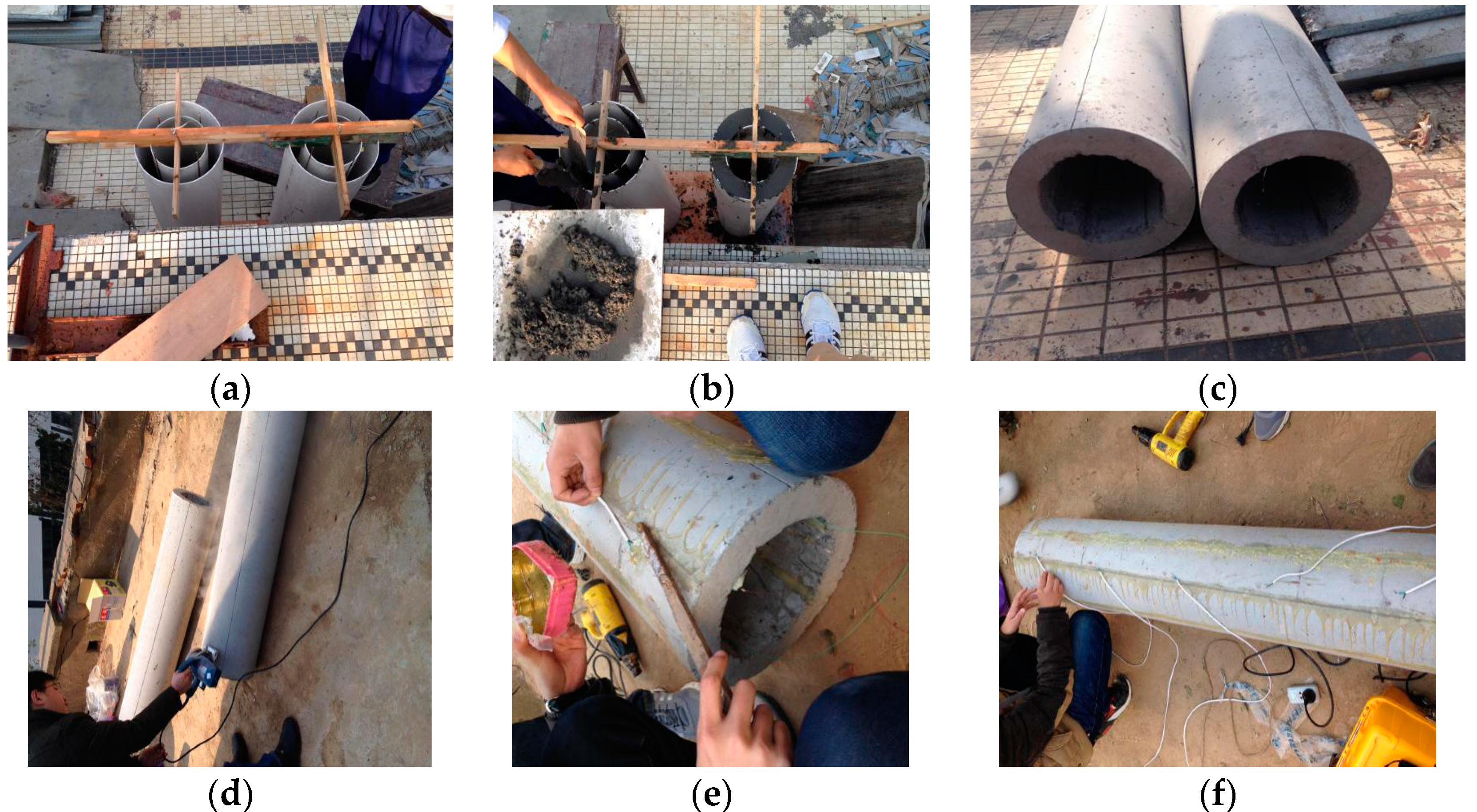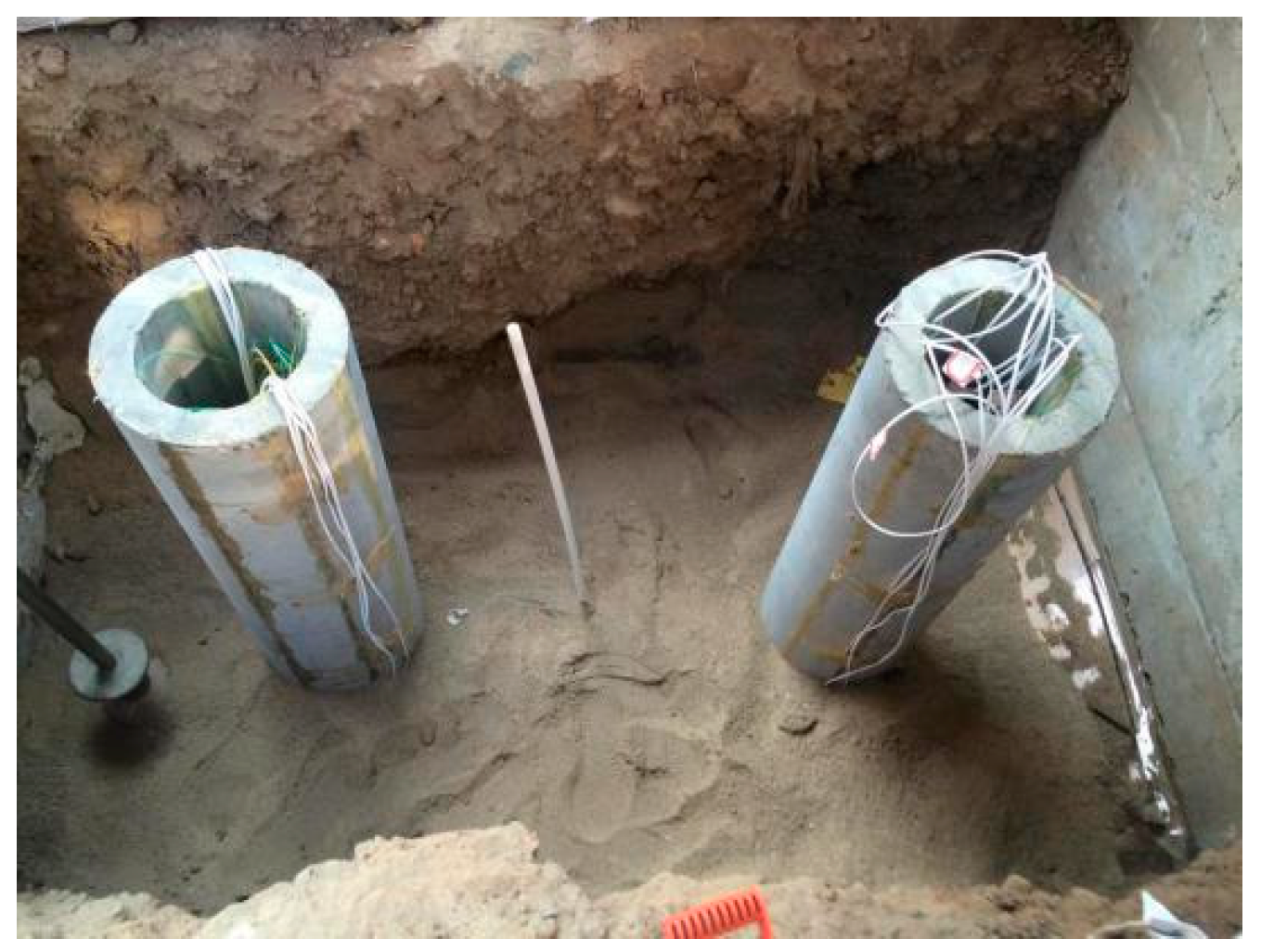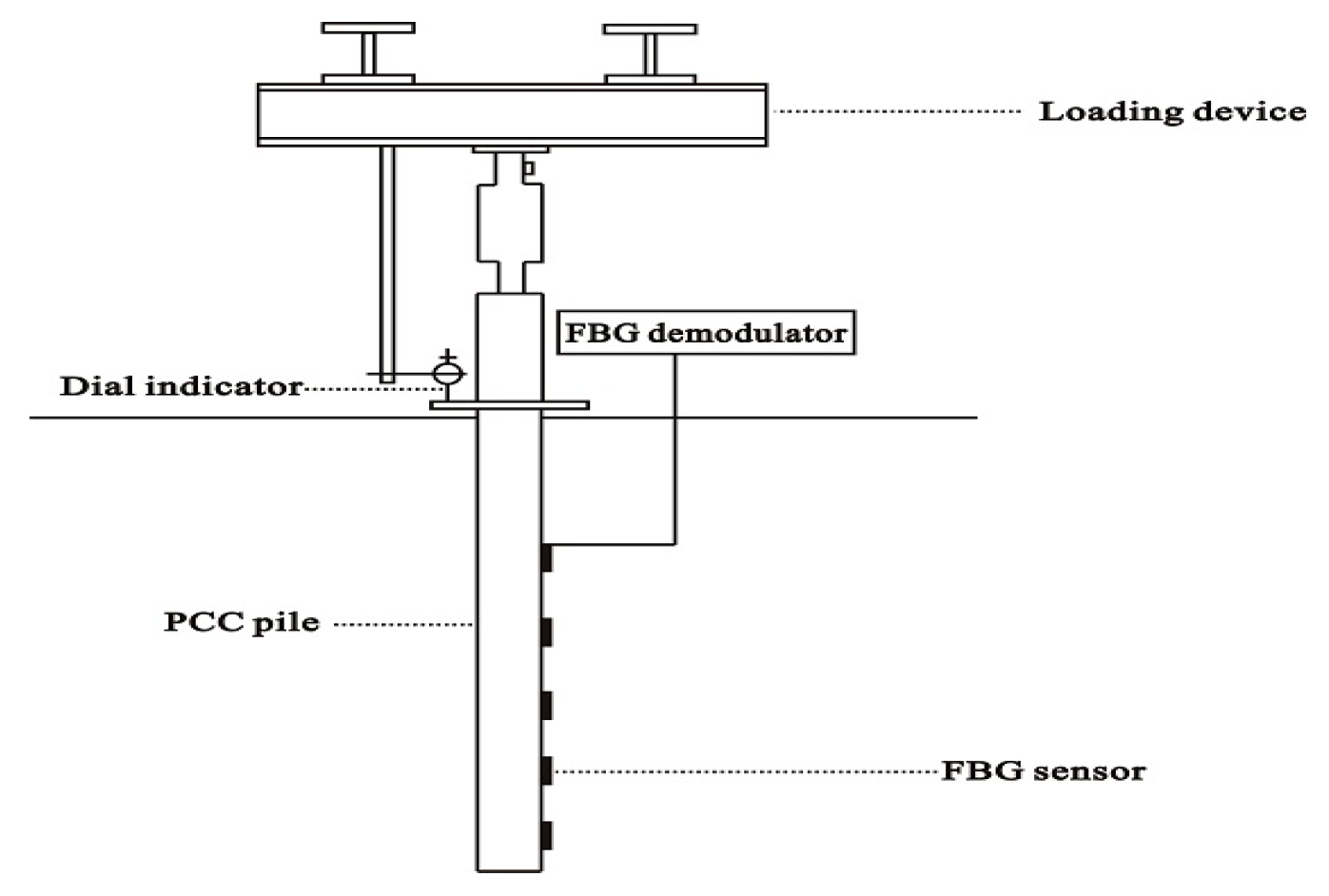Study on the Deformation Measurement of the Cast-In-Place Large-Diameter Pile Using Fiber Bragg Grating Sensors
Abstract
:1. Introduction
2. Materials and Methods
2.1. The PCC Model Pile and Soil
- The line slot and point are fixed along the direction of the PCC pile with the ring. The worker set aside in the groove corresponding to 2 mm of the groove and cut out about 2 mm for the groove. In a PCC pile body under the selection of symmetrical grooves, the paste line of FBG sensors is fixed. On the selected groove, with a marker of the FBG points from the pile top with 20 cm, the middle is every 30 cm between two raster points, with a total of 5 points.
- An optical fiber loose tube is used at the top of the pile, which enables the 0.9 mm optical fiber in the optical fiber loose tube to strengthen the protection, and this will avoid the destruction.
- For the fixed-point paste, the FBG sensor is fixed in the predetermined layout position; the AB glue is used for the FBG sensors around the paste and fixed in the groove of the PCC pile, which provides the FBG sensors with very little pre-stress.
- For the protecting, the epoxy resin adhesive is used and fixed in the groove to protect the FBG sensors.
2.2. Static Load Model Test of the PCC Pile
3. Results
4. Conclusions
- (1)
- Combined with the PCC pile, the construction of the PCC model pile in the static load test was developed; the FBG sensors were first used in the PCC pile, and the fiber laying and protection process were introduced in detail.
- (2)
- According to the monitoring strain data of the PCC pile body based on FBG sensors, the strain curve distribution of the PCC pile body were obtained under a different loading, and the deformation variation characteristics of the PCC pile were studied.
- (3)
- The inner wall and outer wall deformation of the pile body is consistent with the overall change in the law; the strain in the upper part of the decline rate is fast, and the lower part of the rate decreases in speed. It can be seen that, when the loading increases, the strain of the PCC pile also increases. The strain of the PCC pile decreases with the depth under the same loading. This indirectly proves the reliability of the FBG technology for the strain of the PCC pile body. The strain on the inner wall is much smaller than that of the outer wall, because the model pile used in this experiment is small and there is less soil in the inner wall of the pile than there is in the outer wall of the pile.
Acknowledgments
Author Contributions
Conflicts of Interest
References
- Liu, H.L.; Chu, J.; Deng, A. Use of large-diameter, cast-in situ concrete pipe piles for embankment over soft clay. Can. Geotech. J. 2009, 46, 915–927. [Google Scholar] [CrossRef]
- Liu, H.L.; Kong, G.Q.; Ding, X.M.; Chen, Y.M. Performances of Large-Diameter Cast-in-Place Concrete Pipe Piles and Pile Groups under Lateral Loads. J. Perform. Constr. Facil. 2013, 27, 191–202. [Google Scholar] [CrossRef]
- Thach, P.N.; Liu, H.L.; Kong, G.Q. Evaluation of PCC Pile Method in Mitigating Embankment Vibrations from a High-Speed Train. J. Geotech. Geoenviron. Eng. 2013, 139, 2225–2228. [Google Scholar] [CrossRef]
- Liu, H.; Kong, G.; Ng, C.W. Applications of energy piles and technical development of PCC energy piles. Chin. J. Geotech. Eng. 2014, 36, 176–181. [Google Scholar]
- Gao, L.; Ji, B.; Kong, G.; Huang, X.; Li, M.; Mahfouz, A.H. Distributed measurement of temperature for PCC energy pile using BOFDA. J. Sens. 2015, 2015, 610473. [Google Scholar] [CrossRef]
- Gao, L.; Shi, B.; Zhu, Y.; Wang, K.; Sun, Y.; Tang, C. A distributed soil temperature measurement system with high spatial resolution based on BOTDR. Opt. Appl. 2011, 3, 607–616. [Google Scholar]
- Wosniok, A.; Nöther, N.; Krebber, K. Distributed fibere optic sensor system for temperature and strain monitoring based onbrillouin optical-fiber frequency-domian analysis. Procedia Chem. 2009, 1, 397–400. [Google Scholar] [CrossRef]
- Bao, X.; Chen, L. Recent progress in distributed fiber optic sensors. Sensors 2012, 12, 8601–8639. [Google Scholar] [CrossRef] [PubMed]
- Wang, F.; Li, C.; Zhao, X.; Zhang, X. Using a mach-zehnder-interference-based passive configuration to eliminate the polarization noise in Brillouin optical time domain reflectometry. Appl. Opt. 2012, 51, 176–180. [Google Scholar] [CrossRef] [PubMed]
- Galindez-Jamioy, C.A.; Lopez-Higuera, J.M. Brillouin Distributed Fiber Sensors: An Overview and Applications. J. Sens. 2012, 2012, 204121. [Google Scholar] [CrossRef]
- Othonos, A.; Kali, K. Fiber Bragg Gratings, Fundamentals and Applications in Telecommunications and Sensing; Artech House: Boston, MA, USA, 1999; p. 912. [Google Scholar]
- Albert, J.; Shao, L.Y.; Caucheteur, C. Tilted fiber Bragg grating sensors. Laser Photonics Rev. 2013, 7, 83–108. [Google Scholar] [CrossRef]
- Lu, Y.; Shi, B.; Wei, G.Q.; Chen, S.E.; Zhang, D. Application of a distributed optical fiber sensing technique in monitoring the stress of precast piles. Smart Mater. Struct. 2012, 21, 115011–115019. [Google Scholar] [CrossRef]
- Mohamad, H.; Soga, K.; Pellew, A.; Bennett, P.J. Performance monitoring of a secant piled wall using distributed fiber optic strain sensing. J. Geotech. Geoenviron. Eng. 2014, 137, 1236–1243. [Google Scholar] [CrossRef]
- Xiao, H.; Cui, X.; Lei, W. A bored pile deficiency detection method based on optical fiber temperature measurement. Opt. Fiber Technol. 2015, 21, 1–6. [Google Scholar] [CrossRef]
- Pei, H.F.; Yin, J.H.; Zhu, H.H.; Hong, C.Y.; Jin, W.; Xu, D.S. Monitoring of lateral displacements of a slope using a series of special fiber Bragg grating-based in-place inclinometers. Meas. Sci. Technol. 2012, 23, 025007. [Google Scholar] [CrossRef]
- Berruti, G.; Consales, M.; Giordano, M.; Sansone, L.; Petagna, P.; Buontempo, S.; Breglio, G.; Cusano, A. Radiation hard humidity sensors for high energy physics applications using polyimide-coated fiber Bragg gratings sensors. Sens. Actuators B Chem. 2013, 177, 94–102. [Google Scholar] [CrossRef]
- Zhu, H.H.; Shi, B.; Yan, J.F.; Zhang, J.; Wang, J. Investigation of the evolutionary process of a reinforced model slope using a fiber-optic monitoring network. Eng. Geol. 2015, 186, 34–43. [Google Scholar] [CrossRef]
- Zhu, H.H.; Ho, A.N.; Yin, J.H.; Sun, H.W.; Pei, H.F.; Hong, C.Y. An optical fibre monitoring system for evaluating the performance of a soil nailed slope. Smart Struct. Syst. 2012, 9, 393–410. [Google Scholar] [CrossRef]
- Schroeder, K.; Ecke, W.; Apitz, J.; Lembke, E.; Lenschow, G.A. Fibre Bragg grating sensor system monitors operational load in a wind turbine rotor blade. Meas. Sci. Technol. 2006, 17, 1167. [Google Scholar] [CrossRef]
- Wada, D.; Igawa, H.; Kasai, T. Vibration monitoring of a helicopter blade model using the optical fiber distributed strain sensing technique. Appl. Opt. 2016, 55, 6953–6959. [Google Scholar] [CrossRef] [PubMed]
- Cięszczyk, S.; Kisała, P. Inverse problem of determining periodic surface profile oscillation defects of steel materials with a fiber Bragg grating sensor. Appl. Opt. 2016, 55, 1412–1420. [Google Scholar] [CrossRef] [PubMed]
- Zou, H.; Liang, D.; Zeng, J.; Feng, L. Quantum-behaved particle swarm optimization algorithm for the reconstruction of fiber Bragg grating sensor strain profiles. Opt. Commun. 2012, 285, 539–545. [Google Scholar] [CrossRef]





| Parameter | Unit | Model Pile | Parameter | Unit | Model Pile |
|---|---|---|---|---|---|
| Area | S (m2) | 0.046 | Pile length | L (m) | 1.5 |
| Circumference | C (m) | 0.989 | Internal diameter | d (m) | 0.2 |
| External diameter | D (m) | 0.315 | Volume | V (m3) | 0.070 |
| Material | Soil Water Content w (%) | Natural Density ρ (g/cm3) | Thickness (m) |
|---|---|---|---|
| clay | 19.22 | 1.93 | 0.6 |
| sand | 1.33 | 1.70 | 1.6 |
© 2017 by the authors. Licensee MDPI, Basel, Switzerland. This article is an open access article distributed under the terms and conditions of the Creative Commons Attribution (CC BY) license ( http://creativecommons.org/licenses/by/4.0/).
Share and Cite
Gao, L.; Yang, K.; Chen, X.; Yu, X. Study on the Deformation Measurement of the Cast-In-Place Large-Diameter Pile Using Fiber Bragg Grating Sensors. Sensors 2017, 17, 505. https://doi.org/10.3390/s17030505
Gao L, Yang K, Chen X, Yu X. Study on the Deformation Measurement of the Cast-In-Place Large-Diameter Pile Using Fiber Bragg Grating Sensors. Sensors. 2017; 17(3):505. https://doi.org/10.3390/s17030505
Chicago/Turabian StyleGao, Lei, Kai Yang, Xiaorui Chen, and Xiangjuan Yu. 2017. "Study on the Deformation Measurement of the Cast-In-Place Large-Diameter Pile Using Fiber Bragg Grating Sensors" Sensors 17, no. 3: 505. https://doi.org/10.3390/s17030505





